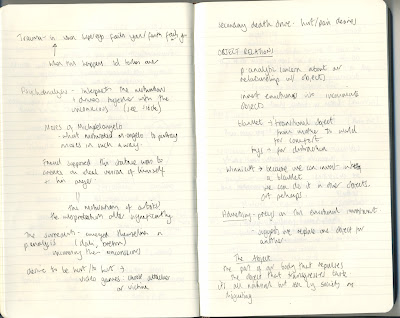
Monday, 7 December 2009
Sunday, 6 December 2009
Adorno Vs Popular Music
According to Adorno there are two spheres of music; popular music and serious music. Popular music is considered to be 'standardized' even when this is avoided. This 'standardization' refers to both technical aspects and the actual content of the song (lyrics).
Due to the similarity of popular songs, Adorno argues that even if details are removed from the song the listener can supply the 'framework'. The listener does not even need to listen to the song, as it is composed in a way that 'dictates' the way it should be heard.
Listeners believe that they're making an individual choice but infact it's been pre-digested for them. For example, record labels make decisions on what people will like and the listeners can choose between types of music i.e genres.
A song can be enforced by being everywhere, this is referred to as plugging. People will then recognise it and associate recognition with liking it. As long as there is a gimmick and is plugged any song can be successful.
There are two types of mass behaviour in response to popular music; 'emotional' and 'rhythmically obedient'.
'Emotional' responses are caused by listeners identifying with the story in the song, this reponse can also be linked to film and tv.
'Rhythmically obedient' responses cause a desire to obey the beat of the song.
Here is an example of a music video which I believe supports Adorno's theory:
The chosen song is "Axel F - Crazy Frog".
Through use of plugging and a gimmick this song managed to become No.1. It makes use of a pre-existing song mixed with the Crazy Frog ringtone. I can't imagine that many listeners would respond emotionally to this song and is more likely to cause rhythmically obedient behaviour.
Due to the similarity of popular songs, Adorno argues that even if details are removed from the song the listener can supply the 'framework'. The listener does not even need to listen to the song, as it is composed in a way that 'dictates' the way it should be heard.
Listeners believe that they're making an individual choice but infact it's been pre-digested for them. For example, record labels make decisions on what people will like and the listeners can choose between types of music i.e genres.
A song can be enforced by being everywhere, this is referred to as plugging. People will then recognise it and associate recognition with liking it. As long as there is a gimmick and is plugged any song can be successful.
There are two types of mass behaviour in response to popular music; 'emotional' and 'rhythmically obedient'.
'Emotional' responses are caused by listeners identifying with the story in the song, this reponse can also be linked to film and tv.
'Rhythmically obedient' responses cause a desire to obey the beat of the song.
Here is an example of a music video which I believe supports Adorno's theory:
The chosen song is "Axel F - Crazy Frog".
Through use of plugging and a gimmick this song managed to become No.1. It makes use of a pre-existing song mixed with the Crazy Frog ringtone. I can't imagine that many listeners would respond emotionally to this song and is more likely to cause rhythmically obedient behaviour.
Tuesday, 24 November 2009
A panoptic example
Visiting the cinema appears to become more panoptic with each visit. With the projector placed at the back of the room high up, surveillance is easily carried out on each visitor at the same time providing 'permanent visibility that assures the automatic functioning of power' (Foucalt in Thomas, 2000 p82). The positioning of the window behind visitors means that member's of the audience 'never know whether [they are] being looked at at any one moment' (Foucalt in Thomas, 2000 p82).
With the introduction of new equipment that can detect filming it means it is not only humans who are surveying but also technology. There are reminders of this power present throughout the visit. From warning displayed before the film, to members of staff, who act as 'representatives of power'(Foucalt in Thomas, 2000 p77), coming into the screen in time intervals to observe audiences.
The constant reminders to audiences that they are being surveyed from an 'omnipresent and omniscient power' (Foucalt in Thomas, 2000 p78) causes self regulation and the rules of the cinema will be followed automatically.
References:
'Panopticism' in Thomas, J. (2000) 'Reading Images', NY, Palgrave McMillan
Subscribe to:
Comments (Atom)























